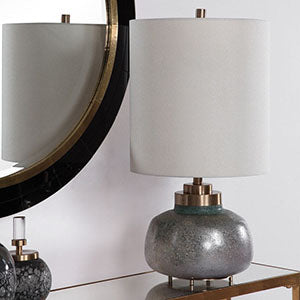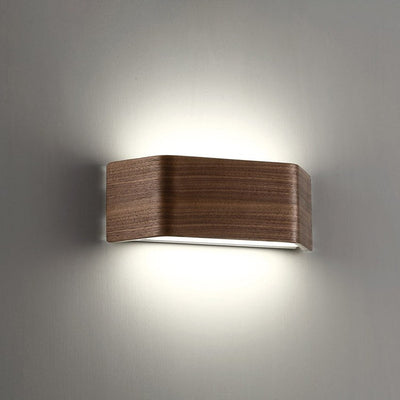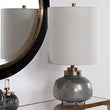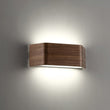Lighting
Home Layered Lighting Design: The Essential Guide for Every Room

Lighting in layers gives every room in your home a welcoming warmth while also providing the brightness you need for activities—from reading a good book to preparing dinner. A layering strategy uses a variety of light fixture types to achieve the look you want with the styles you love. Read on to learn the essentials of light layering, and explore layered lighting design inspiration for every room in your house. Let’s get started!
What Is Light Layering?
Light layering is the process of positioning lights for optimal visibility, ambiance, and aesthetics. It helps bring the interior design of your home to life, lends its own style, and ensures you can see what you are doing.
To help you understand the importance of layered lighting, picture the lighting in a big box store. Large fluorescent ceiling lights situated at one level provide all of the light. Visibility is high, but the light is the same intensity everywhere and not particularly pleasing.
Now picture the light of a romantic restaurant or cozy café. Subtle ceiling lights provide a wash of light across the entire space. Pendant lights provide the light you need to read the menu and see your meal, while wall sconces provide warmth and visual interest. Targeted recessed lights ensure the wait station is well lit, while accent fixtures illuminate charming décor elements. This is layered lighting.

How Do You Layer Light?
Layered lighting balances the three fundamental types of lighting:
- Ambient
- Task
- Accent
The lighting design is considered ‘layered’ because the glow from the different lighting elements overlaps to fill the space. It’s also helpful to think of this lighting approach in three horizontal layers from the ceiling down:
1. Top-layer lighting elements
- Recessed ceiling lights (ambient, task)
- Track lights (ambient, accent)
- Flush and semi-flush mount lights (ambient)
2. Mid-layer lighting elements
- Pendant lights (ambient, task, accent)
- Chandeliers and island lights (ambient, task, accent)
- Tall uplight floor lamps (ambient, accent)
- Over-the-mirror vanity lights (task, accent)
- Ceiling fans with lights (ambient)
3. Lower-level lighting elements
- Wall sconces (task, accent)
- Side-of-the-mirror vanity lights (task, ambient)
- Undercabinet lights (task, accent)
- Floor lamps (task, ambient)
- Bedside lamps (task, accent)
- Side table lamps (task, accent)
Varying brightness between elements is another important feature of layered lighting. Overhead and side table lights should be bright enough to illuminate the area where you are cooking or reading, while wall sconces cast a soft, warm glow.
Finally, layered lighting design gives you options. You can turn off certain lights and flip others on, depending on your activities. Or, you can use a dimmer to increase and decrease the brightness of specific fixtures as needed.
Now let’s take a look at how layered lighting can work in every room of your home.
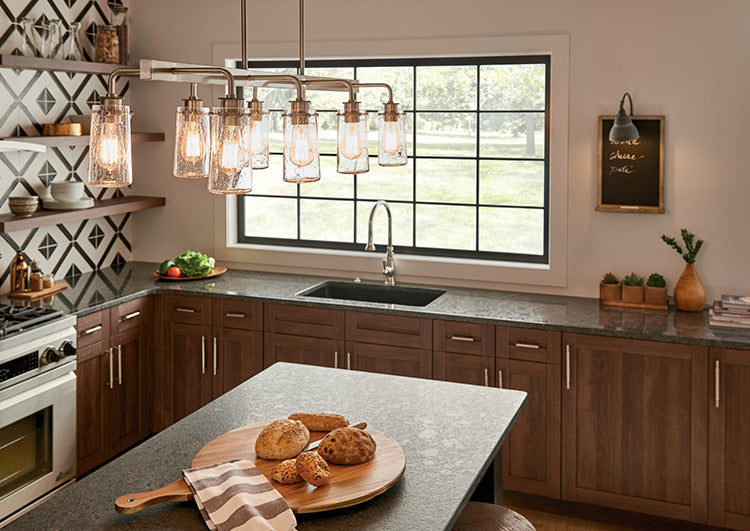
Layered Lighting in the Kitchen
Is your kitchen the center of the household? Do family members cook, gather, and do their homework here? Or, does your home have a galley kitchen used exclusively for cooking and cleaning up? Take a moment to review the busiest spots in your kitchen and build your layered lighting design from those areas outward. Some possible layouts:
Island chandelier + undercabinet lighting + pendants. If the kitchen island is the center of your household, a bright island chandelier provides style and ambient light for homework and meal prep. You’ll be able to find a multi-light chandelier to match your kitchen style, whether that’s Craftsman, farmhouse, modern, or a mix of styles. Add a layer of under-cabinet lights to boost countertop lighting and provide an elegant glow. Finally, add two pendants above the sink, or a pendant above the breakfast nook table so you’ll have enough light for meals and cleanup.
Recessed lights + wall sconces + mini chandelier. For medium-sized kitchens with countertop workspaces and a dining table, recessed fixtures provide abundant ambient light to the entire room. Add swing arm pendants with colorful glass covers to add vibrant style on either side of the sink or stove. Finish the look with a bold, but small chandelier over the table.
Track lighting + pendants. Versatile track lighting combined with pendant lights creates enough layered lighting for a galley or corridor-style kitchen. Track lighting in a curvy, matte metallic design adds graceful style and ambient light at the ceiling. The pendant provides a focused boost of lighting above a work area or a peninsula counter. A pendant with wood elements delivers farmhouse charm, or you can add eclectic elegance with a glass pendant featuring a distinctive silhouette

Layered Lighting in the Living Room
No matter the style of your living room, you can design layered lighting that is at once beautiful and useful. Lighting layouts to consider:
Recessed lights + wall sconces + table lamps. Install a row of recessed lights above the mantle to illuminate any decorative accents you set there. Connected to a dimmer, recessed lights are adjustable to your preferred brightness. Add wall sconces on either side of a recessed bookcase or large-scale piece of wall art. Finally, choose table lamps on both sides of the couch and beside a leather or upholstered club chair.
Semi-flush mount light + two-light torchière + pendants. Semi-flush mount lights drop down from the ceiling, but not as far as a chandelier or pendant. Choose one with a drum shade in antique white with chrome accents for a style that works with transitional and contemporary décor. A torchière light bounces more light off the ceiling, and provides task lighting when positioned near a table or armchair. Install pendants on either side of a large mirror or on either side of built-in elements, such as bookshelves or cabinets.
Chandelier + floor lamps + directional recessed lights. Add a statement piece to your living room with a glamorous chandelier. Choose one with a spray of exposed bulbs, an elegant black drum shade, or a nested geometric design. Add floor lamps beside a chair or couch. Install directional recessed fixtures around the room to aim light where needed, or along the edge of one textured wall.

Layered Lighting in the Bathroom
Even though it’s a small space, your bathroom lighting should still be layered with task, accent, and ambient lighting. This way you can see clearly at any time of day and the lighting looks lovely, too.
Linear vanity lights + recessed lights + chandelier. Vanity lights across the top, or along both sides of your bathroom mirror give you essential task lighting. Recessed lights (set at a low level) provide dim light for evenings and the middle of the night. A chandelier adds drama, especially if it’s colorful or shimmering.
Pendants + wall sconces + shower recessed lights. Pendants are a chic alternative to traditional vanity lights. Choose three or four in a style and color you love and install them above your bathroom sink, with the bottom of the pendant aligned with the top of the mirror. Wall sconces to either side or on an accent wall help minimize shadows. For master baths with large walk-in showers, recessed lights with a damp safety rating are a must.
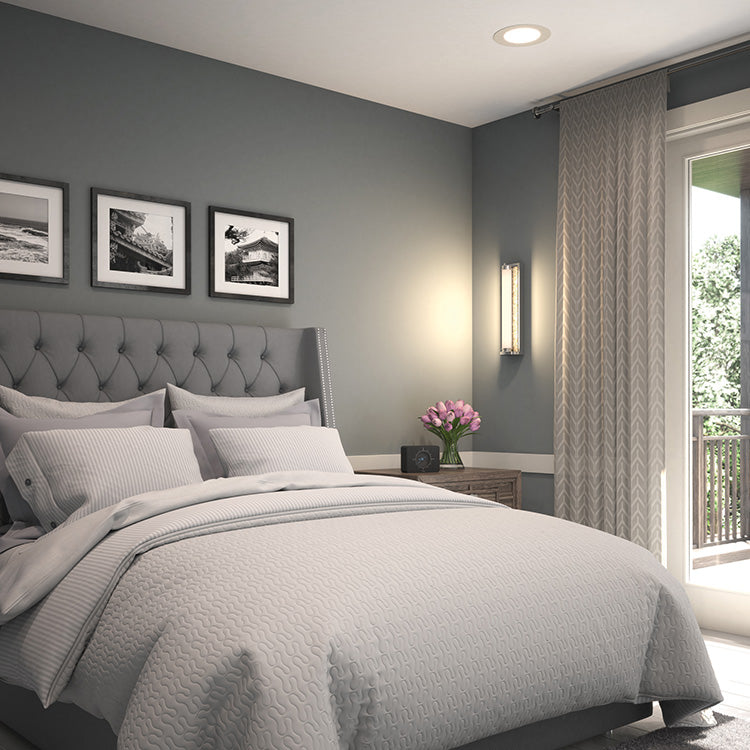
Layered Lighting in the Bedroom
The goal of layered lighting in the bedroom is to give you the illumination you need to get ready in the morning and wind down for sleep at night.
Recessed lights + semi-flush light + bedside table lamps. With recessed lights on a dimmer, you can control the brightness. Turn it up when you are matching clothes, turn it low when you are getting ready for bed. A semi-flush light provides stylish overhead lighting perfect for putting away laundry or making the bed. Finally, table lamps give you the light you need to read a book in bed, and they’re easy to turn off when it’s time to turn in.
Statement chandelier + wall sconces + floor lamps. This is your space: Make the most of it with a statement chandelier that captures your favorite style. Choose a chandelier with a cascade of light-catching crystals. Or, expand on your industrial-chic aesthetic with a linear chandelier showcasing metallic hardware and exposed Edison-style bulbs.

Layered Lighting in the Foyer
Lighting is important in this transitional space. Here, layered lighting should provide warm and welcoming light for you and visitors, and provide the light you need when tying shoes, finding your car keys, and grabbing your coat.
Foyer pendant + recessed lighting. Entry lighting is an excellent opportunity to proclaim your home style. Classic? Modern? Farmhouse? Choose a pendant light that reflects your design style and you’ll set the stage for the rest of the house. A light fixture with polished metal spheres around an etched glass shade matches with both contemporary and transitional interiors. A combination of wood and metal elements complements rustic, farmhouse, and industrial styles. The addition of recessed lights—preferably on a dimmer—offers bright task lighting for sorting mail or cleaning.
Chandelier + flush mount light + wall sconces. This is a beautiful layout for an entrance hall with a curved or L-shaped staircase. Install a flush mount fixture that adds color and warmth to space in the center of the hall. Wall sconces in a complementary style lead the way to interior rooms and provide mid-level lighting. A chandelier above your staircase landing is the scene-stealer. Choose the right size chandelier for the space, but take this opportunity to go bold with a glamorous or sculptural hanging light.

Layered Lighting in the Dining Room
In many homes, the dining room is a ‘sometimes’ space. Your family may gather there for dinner or even only on special occasions. Layered lighting in this space usually includes welcoming light above the dining room table and accent lighting to add interest.
Track lighting + table lamps + classic chandelier. A chandelier above the dining room table is traditional. Choose one with crystal accents and candle-style light fixtures to convey classic elegance. Buffet table lamps add task lighting on a sideboard or console, where the host may mix cocktails or set out appetizers. For a final layer, add track lighting along the long walls of the dining room to boost the light from the chandelier and illuminate wall art.
Recessed lights + wall sconces + chandelier. Recessed lights on dimmers are perfect for setting the right mood—go lower for a romantic dinner for two, and higher for family-style meals. Linear chandeliers illuminate the length of the dining room table. Choose a linear chandelier with clean lines and caramel frosted glass to complement Craftsman-style décor. Or, choose a brushed metallic chandelier with layered glass light covers for a contemporary look. Directional recessed lights let you target the beams towards wall art or the buffet table. Finally, colorful wall sconces add interest on either side of a tall cabinet or at the head of the table.
Done well, light layering fills a room with warmth and beauty. Look around your home to see if there are any layers missing, so you can fill in the brightness wherever needed.

